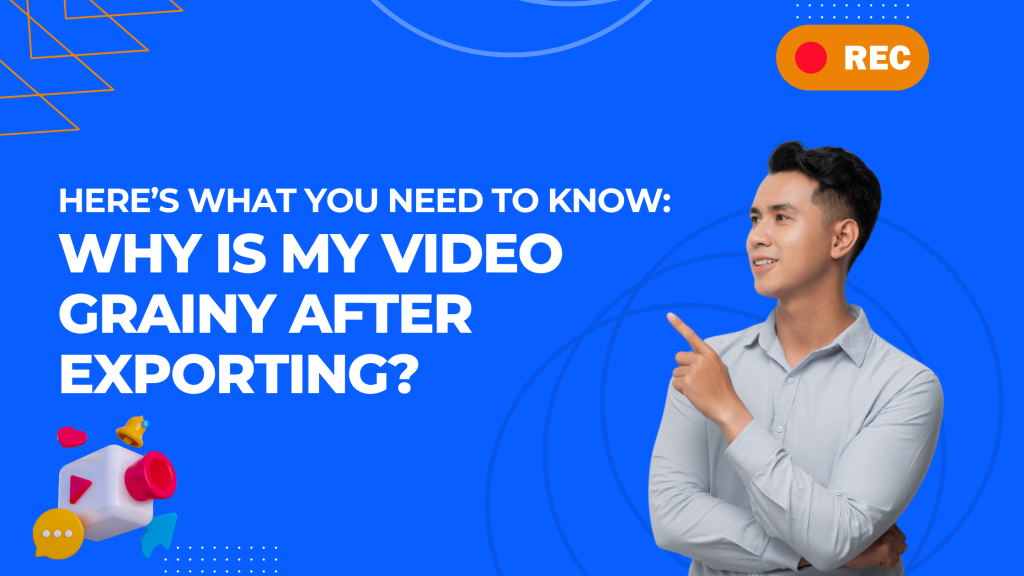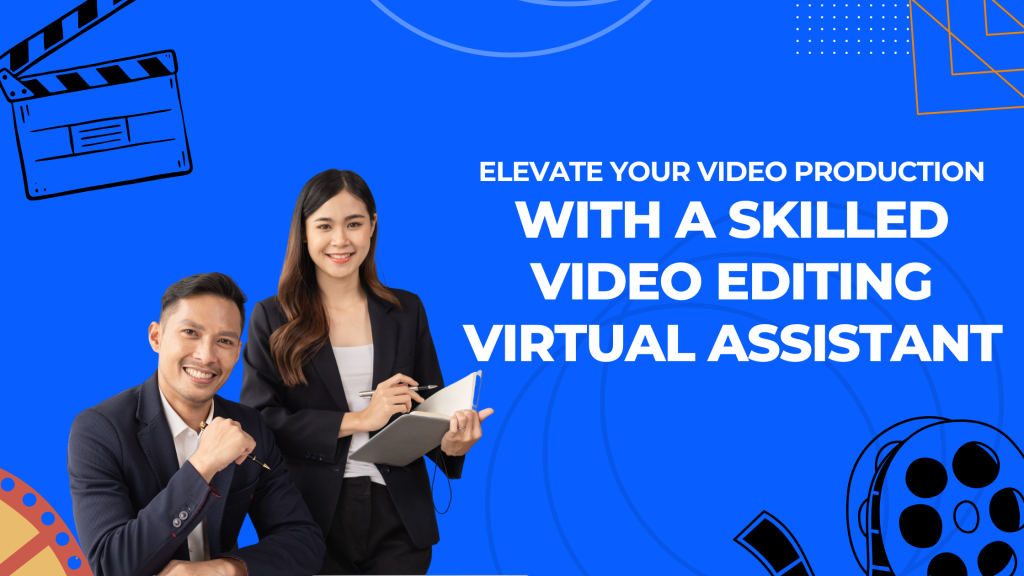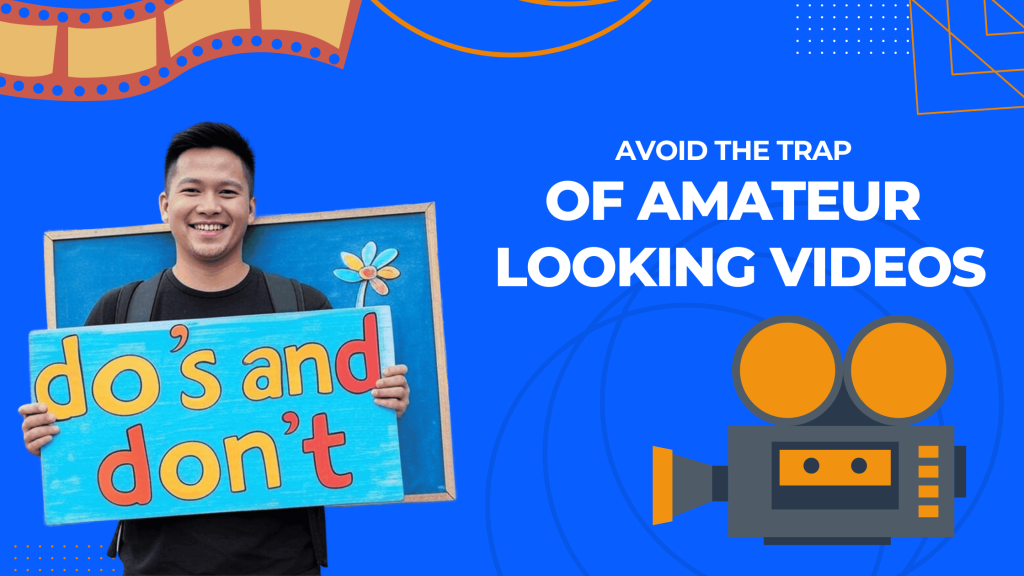Why Is My Video Grainy After Exporting? Here’s What You Need to Know

Home About Services Blog Go High Level Graphics Design Video Editing SEO Project Management Customer Service Bookkeeping Get Started Home About Services Blog Go High Level Graphics Design Video Editing SEO Project Management Customer Service Bookkeeping Get Started Home About Services Blog Go High Level Graphics Design Video Editing SEO Project Management Customer Service Bookkeeping Get Started Home About Services Blog Go High Level Graphics Design Video Editing SEO Project Management Customer Service Bookkeeping Get Started Why Is My Video Grainy After Exporting? Here’s What You Need to Know Jan 20, 2025 | Ken Llana You’ve spent hours, maybe days, creating the perfect video. You carefully shot the footage, added stunning transitions, and polished every frame. But then comes the final step: exporting. You hit the button, excited to see your masterpiece—and then it happens. The video plays, but instead of crisp, vibrant visuals, you’re staring at a grainy mess. Frustrating, right? Grainy video exports are a common headache for beginners and even seasoned creators. Whether you’re a business owner crafting marketing content or a budding filmmaker building your portfolio, grainy videos can derail your project’s impact. Video quality isn’t just about aesthetics; it’s about credibility. A blurry, noisy video can send the wrong message, diminishing the hard work you’ve poured into your project. Such issues can happen due to a multitude of reasons. For instance, is your camera functioning optimally? Perhaps the lighting isn’t right? Or the problem stems from the way in which the file was exported? All of these questions can lead us to one answer, which is yes, multiple things can cause grainy videos post exporting. Some even stem from recording conditions such as bad or low lighting, setting the resolution lower than the graphics requires, or exporting with higher compression settings than are required. But the silver lining is that such issues are not permanent, and can be solved with time. In this article, we’ll explore why your videos lose quality after export and—more importantly—how to fix it. We’ll cover everything from export settings and codecs to lighting techniques and noise reduction tools. You’ll learn actionable strategies to ensure your final product looks just as good as it does in the editor. This guide will get you up to speed to help you shoot professional-level videos which you can be proud of in no time at all. So, you want to level up your video projects? Let’s jump in! Common Causes of Grainy Videos After Export What Are the Typical Reasons for Grainy Videos Post-Export? There are several likely reasons that post-export videos end up grainy, the most notable of which is the incorrect export settings. Starting with export settings, if the footage is exported at a lower resolution than it is shot, it creates a demerit as clarity is lost. This is not unlikely as a low bitrate can cripple a video by not supporting its level of quality which results in visuals being grainy or muddy. Next, there’s compression. Over-compression strips away fine details, leaving your video looking flat and noisy. Plus, some codecs—those behind-the-scenes tech tools that handle video encoding—aren’t designed for high-quality exports, further reducing visual fidelity. These are key aspects of the recording as well as the surroundings. It’s usually when shooting along with high iso noise that becomes unsightly after the media has been exported. Finally, editing effects can amplify graininess. Overusing filters or pushing color grading too far distorts the footage, enhancing any pre-existing flaws. Each step matters—so handle with care! Solutions to Prevent Grainy Exports How Can You Optimize Export Settings? Start with the export resolution and adjust it to match your source footage for maximum video clarity. Export in 4k quality if your footage is already 4k! Reducing the resolution will compromise the sharpness as well as detailing, resulting in a grainy video. Next, pay attention to the bitrate. A higher bitrate preserves more data, resulting in crisper visuals. Think of it as the difference between a high-quality and low-quality streaming service—more bitrate equals better quality. Also, select the proper codec. For a majority of tasks, H.264 formats offer an acceptable compromise between quality and size, though if outmost quality is necessary, take ProRes or DNxHD. Lastly, take care not to compress the video files too much. Indeed, there are some linguistic sites that attend to the compression of videos that make claims about achieving wonders in reduction of file size, but then there is the quality aspect that suffers in the end. Do keep this caveat in mind. Use brief video clips as test gardens to set the parameters that will work best for you. With adequate tweaks, the video will be none too comparable. Which Codecs Should You Use? Selecting the right codec is very critical in video quality. A codec is like a tool that compresses and decompresses your video file. Therefore, it is essential to choose a codec which offers an acceptable balance between quality and file size. For general use, H. 264 is a safe choice. It provides good quality while also having a reasonable file size which makes it perfect for sharing and streaming over the web. In professional environments or for certain projects that require the utmost detail and realism, remember to check out ProRes or DNxHD. These codecs preserve greater detail when compared to others, so their uses are very common in films and TV productions. Definitely file sizes are bulkier, however the visual fidelity is worth it! For enhanced animation or video footage which is unable to be compressed, then use H.265 (HEVC – High Efficiency Video Coding). This codec is capable of maintaining quality while reducing the size of the file. Just like how there is a suitable codec for each task, the objectives for what final output is targeted needs to be understood. Please be careful! How Can Recording Techniques Be Improved? Ensure Proper Lighting To eliminate strong shadows, apply softened light which is equally dispersed. For balanced light, angle the camera 45 degrees
The Future of Video Editing: AI and Machine Learning

Home About Services Blog Go High Level Graphics Design Video Editing SEO Project Management Customer Service Bookkeeping Get Started Home About Services Blog Go High Level Graphics Design Video Editing SEO Project Management Customer Service Bookkeeping Get Started Home About Services Blog Go High Level Graphics Design Video Editing SEO Project Management Customer Service Bookkeeping Get Started Home About Services Blog Go High Level Graphics Design Video Editing SEO Project Management Customer Service Bookkeeping Get Started The Future of Video Editing: AI and Machine Learning Dec 20, 2024 | Ken Llana We are in an era where Artificial Intelligence (AI) and Machine Learning (ML) technologies are highest at their transformation stage and working side by side with the emergence of new video editing practices. The advancement has reached a stage where what was considered manual work needing expertise can now be completely automated, and in the process, creators are able to produce higher quality videos. But what does this future hold for us? How will AI and ML change the practices of video editing? Let’s talk about it. Get Started The Role of AI in Modern Video Editing AI has already made significant inroads into video editing by automating repetitive tasks, enhancing creativity, and improving the overall workflow. Key areas where AI is making an impact include: 1. Automated Video Trimming and Editing AI-powered tools can analyze hours of footage and identify key moments, cutting down on the tedious process of sifting through raw video. For instance, platforms like Adobe Premiere Pro and Final Cut Pro have integrated AI features that automatically suggest edits based on the content’s rhythm and flow. 2. Smart Effects and Enhancements Advanced AI algorithms can apply color corrections, stabilize shaky footage, and even enhance audio quality. These features save hours of manual adjustments and ensure a consistent, polished look across videos. 3. Speech and Object Recognition AI can transcribe spoken dialogue, identify objects in a scene, and even tag these elements for easier editing. This functionality is particularly useful for documentary filmmakers, educators, and marketers who need to categorize and search through large volumes of content quickly. Machine Learning: The Driving Force Behind AI in Video Editing Machine Learning, a subset of AI, enables software to learn and adapt from data, making it an essential component of modern video editing. ML algorithms are trained on massive datasets to recognize patterns, predict outcomes, and refine editing processes over time. 1. Personalized Editing Suggestions ML algorithms can analyze a creator’s editing style and offer tailored suggestions. For example, if a videographer consistently prefers a certain type of transition or color grading, ML can predict and apply these preferences automatically. 2. Dynamic Content Adaptation In an era of multi-platform content, ML helps optimize videos for different formats and audiences. Whether it’s converting a landscape video into a vertical format or adjusting content for regional preferences, ML ensures seamless adaptability. 3. Predictive Analytics for Better Storytelling Machine Learning tools can analyze audience behavior and predict which elements of a video will perform best. This insight allows editors to craft content that resonates more effectively with their target audience. Image Source: https://elements.envato.com/learn/top-ai-tools-for-video-creators Image Source: https://zapier.com/blog/best-ai-video-generator/ Boost Your Productivity Now Current AI and ML Tools Revolutionizing Video Editing Several tools and platforms are already harnessing the power of AI and ML to transform video editing workflows: Runway ML: This tool provides creators with intuitive AI-powered features, such as background removal and text-to-video generation. Magisto: An AI-driven video editor that simplifies the creation process by automatically selecting the best scenes and applying professional effects. Descript: A text-based editing tool that uses AI to transcribe audio, allowing editors to cut and modify videos as easily as editing a document. DeepArt: This tool applies artistic styles to videos using neural networks, offering creators unique and visually striking results. The Benefits of AI and ML in Video Editing The integration of AI and ML into video editing brings a host of advantages: 1. Increased Efficiency AI automates time-consuming tasks, allowing editors to focus on the creative aspects of their work. This efficiency is especially valuable for businesses producing high volumes of video content. 2. Cost-Effective Solutions By reducing the need for extensive manual labor, AI and ML tools lower production costs without compromising quality. Freelancers and small businesses, in particular, benefit from these cost savings. 3. Enhanced Accessibility AI democratizes video editing by making advanced features accessible to non-professionals. User-friendly interfaces and guided workflows empower anyone to create high-quality videos. Challenges and Ethical Considerations While the benefits of AI and ML in video editing are undeniable, they also present unique challenges and ethical concerns: 1. Loss of Human Touch Some critics argue that over-reliance on AI can strip videos of their emotional depth and individuality. Striking a balance between automation and creativity is crucial. 2. Bias in Algorithms ML models are only as good as the data they’re trained on. Biased datasets can lead to flawed outcomes, such as misrepresentation in content tagging or stereotyping in video suggestions. 3. Job Displacement As AI takes over repetitive tasks, some fear it may reduce opportunities for entry-level video editors. However, it also creates new roles that require expertise in AI tools and workflows. The Future: What Lies Ahead? The future of video editing is brimming with possibilities. Here are some trends we can expect: 1. AI-Driven Storyboarding Imagine software that drafts a storyboard based on a script, complete with scene suggestions and camera angles. AI could make this a reality, further streamlining the pre-production process. 2. Real-Time Editing With advancements in processing power, AI may enable real-time editing capabilities, allowing creators to see polished versions of their work instantly. 3. Virtual Reality (VR) Integration AI will play a significant role in editing VR content, which requires 360-degree spatial awareness and precision. 4. Hyper-Personalized Content As consumer preferences become increasingly diverse, AI will enable the creation of hyper-personalized videos tailored to individual tastes
Elevate Your Video Production with a Skilled Video Editing Virtual Assistant

Home About Services Blog Go High Level Graphics Design Video Editing SEO Project Management Customer Service Bookkeeping Get Started Home About Services Blog Go High Level Graphics Design Video Editing SEO Project Management Customer Service Bookkeeping Get Started Home About Services Blog Go High Level Graphics Design Video Editing SEO Project Management Customer Service Bookkeeping Get Started Home About Services Blog Go High Level Graphics Design Video Editing SEO Project Management Customer Service Bookkeeping Get Started Elevate Your Video Production with a Skilled Video Editing Virtual Assistant Dec 20, 2024 | Ken Llana For all types of businesses, video content has become a ‘must-have’ asset in this fast-evolving technological era. For a new business owner, marketer, or content creator, premium video production can enhance exposure and engagement of your business to a great extent. However, videos are quite a labor and time-consuming process, which should revolve around creating and editing the footage. A video editing virtual assistant can be of great help in this case. Get Started What is a Video Editing Virtual Assistant? A video editing virtual assistant is a remote professional who specializes in editing video content. They are skilled in using various video editing software, such as Adobe Premiere Pro, Final Cut Pro, and DaVinci Resolve, to transform raw footage into polished, professional videos. By outsourcing your video editing tasks to a virtual assistant, you can free up valuable time and resources, allowing you to focus on other critical aspects of your business. The Benefits of Hiring a Video Editing Virtual Assistant The Benefits of Hiring a Video Editing Virtual Assistant Time Savings: A skilled video editing virtual assistant can efficiently edit your videos, saving you countless hours of work. Cost-Effective: Hiring a virtual assistant is often more cost-effective than hiring a full-time in-house editor. Expertise: Virtual assistants have the expertise and experience to create high-quality videos that meet your specific needs. Flexibility: Virtual assistants can work remotely, providing you with flexibility and convenience. Scalability: You can easily scale your video production efforts by hiring additional virtual assistants as needed. Image Source: https://blog.hubspot.com/blog/tabid/6307/bid/29075/12-tips-to-instantly-enhance-video-production-quality.aspx Image Source: https://riverside.fm/blog/corporate-video-production Boost Your Productivity Now Key Skills and Qualities to Look for in a Video Editing Virtual Assistant When hiring a video editing virtual assistant, it’s essential to look for someone with the following skills and qualities: Proficiency in Video Editing Software: A strong understanding of industry-standard video editing software, such as Adobe Premiere Pro, Final Cut Pro, or DaVinci Resolve. Creative Vision: The ability to understand your brand’s aesthetic and create visually appealing videos that align with your message. Attention to Detail: Meticulous attention to detail to ensure that every aspect of the video is perfect. Time Management Skills: The ability to manage multiple projects and meet deadlines efficiently. Strong Communication Skills: Effective communication to understand your requirements and provide updates on project progress. Adaptability: The ability to adapt to changing project requirements and feedback. Technical Proficiency: A good understanding of video formats, codecs, and resolution. How to Find a Reliable Video Editing Virtual Assistant There are several ways to find a reliable video editing virtual assistant: Freelance Platforms: Websites like Upwork, Freelancer, and Fiverr offer a wide range of video editing freelancers. Virtual Assistant Agencies: These agencies can help you find and hire skilled virtual assistants. Social Media: Platforms like LinkedIn and Twitter can be used to connect with potential virtual assistants. Word-of-Mouth: Ask your network of contacts for recommendations. Tips for Working Effectively with a Video Editing Virtual Assistant To ensure a smooth and productive working relationship with your video editing virtual assistant, consider the following tips: Clear Communication: Clearly communicate your vision, expectations, and deadlines. Provide Detailed Instructions: Provide detailed instructions and guidelines for the video editing process. Regular Check-ins: Schedule regular check-ins to discuss project progress and address any questions or concerns. Provide Timely Feedback: Provide timely and constructive feedback to help your virtual assistant improve their work. Trust and Respect: Build a strong relationship based on trust and respect. By following these tips, you can effectively collaborate with your video editing virtual assistant to create high-quality videos that help you achieve your business goals. Start Growing Your Business Today! Here’s a Video About How You Can Improve Your Video Production https://youtu.be/PzBy_XfgJLE?si=DW618-fSwSiQDMbB A proficient video editing virtual assistant can add great value to your company. By delegating your video editing responsibilities, you can use your time more efficiently, save costs and enhance the quality of your video content. Such things as skills and other attributes of the virtual assistant that you need should be well borne in mind, and clear communication and understanding of expectations established from the word go. Previous Next Contact Us Related Posts December 20, 2024 The Future of Video Editing: AI and Machine Learning Home About Services Blog Go High Level – Article… Posted By Ken December 20, 2024 Elevate Your Video Production with a Skilled Video Editing Virtual Assistant Home About Services Blog Go High Level – Article… Posted By Ken December 20, 2024 Avoid the Trap of Amateur-Looking Videos: How a Video Editing VA Protects Your Brand Home About Services Blog Go High Level Graphics Design… Posted By Ken Join Our Newsletter Name Email Address Send Privacy Policy Terms and Condition Connect With Us Privacy Policy Term and Condition
Avoid the Trap of Amateur-Looking Videos: How a Video Editing VA Protects Your Brand

Home About Services Blog Go High Level Graphics Design Video Editing SEO Project Management Customer Service Bookkeeping Get Started Home About Services Blog Go High Level Graphics Design Video Editing SEO Project Management Customer Service Bookkeeping Get Started Home About Services Blog Go High Level Graphics Design Video Editing SEO Project Management Customer Service Bookkeeping Get Started Home About Services Blog Go High Level Graphics Design Video Editing SEO Project Management Customer Service Bookkeeping Get Started Avoid the Trap of Amateur-Looking Videos: How a Video Editing VA Protects Your Brand Dec 20, 2024 | Ken Llana In a world dominated by visual content, videos are the cornerstone of a successful digital presence. From social media platforms to professional presentations, videos allow brands to connect with audiences in a dynamic and engaging way. But there’s a fine line between captivating your audience and losing credibility—and that line often lies in the quality of your video editing. This is where a Video Editing Virtual Assistant (VA) steps in to elevate your brand and ensure your content stands out for all the right reasons. Get Started The Danger of Amateur-Looking Videos First impressions matter. Poorly edited videos can send the wrong message about your brand, leaving viewers with a perception of unprofessionalism. Whether it’s inconsistent transitions, mismatched audio, or a lack of polish, amateur-looking videos can: Undermine Your Brand’s Credibility: Viewers may associate low-quality visuals with a lack of professionalism or attention to detail. Reduce Audience Engagement: Poor editing can disrupt the flow of your message, causing viewers to click away. Limit Your Marketing ROI: Subpar videos fail to make an impact, leading to wasted time and resources. These risks make it essential to prioritize quality when producing video content, regardless of the platform or purpose. How a Video Editing VA Transforms Your Content A Video Editing Virtual Assistant is more than just a remote team member; they are your partner in creating high-quality, visually appealing videos. Here’s how they help you avoid the pitfalls of amateur editing: 1. Professional Editing Expertise Video Editing VAs bring specialized skills and experience to your projects. From seamless transitions to color correction, they know the nuances that make a video visually stunning and engaging. Their attention to detail ensures your content aligns with your brand’s image and message. 2. Consistency Across All Content Maintaining consistency in style, tone, and branding is crucial for building recognition. A Video Editing VA ensures that every piece of video content reflects your brand’s identity, helping to establish trust and familiarity with your audience. 3. Time and Resource Efficiency Editing videos can be a time-intensive process, especially for those without a background in video production. Delegating this task to a VA allows you to focus on strategic and creative aspects of your business while they handle the technical details. 4. Enhanced Storytelling A well-edited video is more than just polished visuals; it’s a compelling story. Video Editing VAs are skilled at arranging clips, adding music, and incorporating effects that captivate viewers and deliver your message effectively. 5. Adaptability for Different Platforms Each platform has unique requirements and audiences. Whether it’s a snappy Instagram reel or an informative YouTube video, a Video Editing VA ensures your content is optimized for its intended platform, maximizing its impact. Image Source: https://blog.hubspot.com/blog/tabid/6307/bid/29075/12-tips-to-instantly-enhance-video-production-quality.aspx Image Source: https://www.adorama.com/alc/13-videography-tips-for-more-professional-looking-videos/ Boost Your Productivity Now Why Hiring a Video Editing VA Is a Smart Investment Outsourcing video editing to a professional VA offers a cost-effective solution without compromising quality. Unlike hiring a full-time employee, you can scale the VA’s workload based on your needs, paying only for the services you require. Moreover, many VAs stay up-to-date with the latest trends and tools, ensuring your videos remain relevant and competitive in a constantly evolving market. Real-Life Examples of Impact: Small Business Success: A boutique clothing brand significantly improved its social media engagement by partnering with a Video Editing VA. Their polished product showcase videos attracted more viewers, leading to increased sales. Thought Leader Growth: A consultant grew their online presence by producing high-quality educational videos with the help of a VA. The professional editing boosted their credibility and brought more clients to their services. Tips for Collaborating with a Video Editing VA To get the most out of your partnership, consider these tips: Communicate Your Vision: Share your branding guidelines, preferred styles, and project goals. Provide Clear Feedback: Constructive feedback helps the VA understand your preferences and improve future work. Leverage Tools: Use platforms like Trello, Google Drive, or Slack to streamline collaboration and track progress. Here’s a Video on How You Can Improve Lighting on Your Videos https://www.youtube.com/watch?v=6q-AYiTFUo4 In this day and age, video footage is an asset or is certainly able to be utilized as an asset for the business fail to utilize video in their strategy then it stands to reason their operations will tell a different story. Building features of a fully fledged and professional brand requires a great deal and initiation, avoiding looking amateur engrossing your specific target market and achieving positive results. A Video Editing Virtual Assistant offers the needed skills and resources to not only inter-cut attention-grabbing content that would lift off and even build on the reputation of the brand but also protect it. Shoddy videos are detrimental to the development and expansion of any relevant brand. They put a strain on the bones of the organization. Hire a Video Editing VA now and take your content as well as your firm to the next level. Start Growing Your Business Today! Previous Next Related Posts December 20, 2024 The Future of Video Editing: AI and Machine Learning Home About Services Blog Go High Level – Article… Posted By Ken December 20, 2024 Elevate Your Video Production with a Skilled Video Editing Virtual Assistant Home About Services Blog Go High Level – Article… Posted By Ken December 20, 2024 Avoid the Trap of Amateur-Looking Videos: How a Video Editing VA Protects Your Brand Home About Services